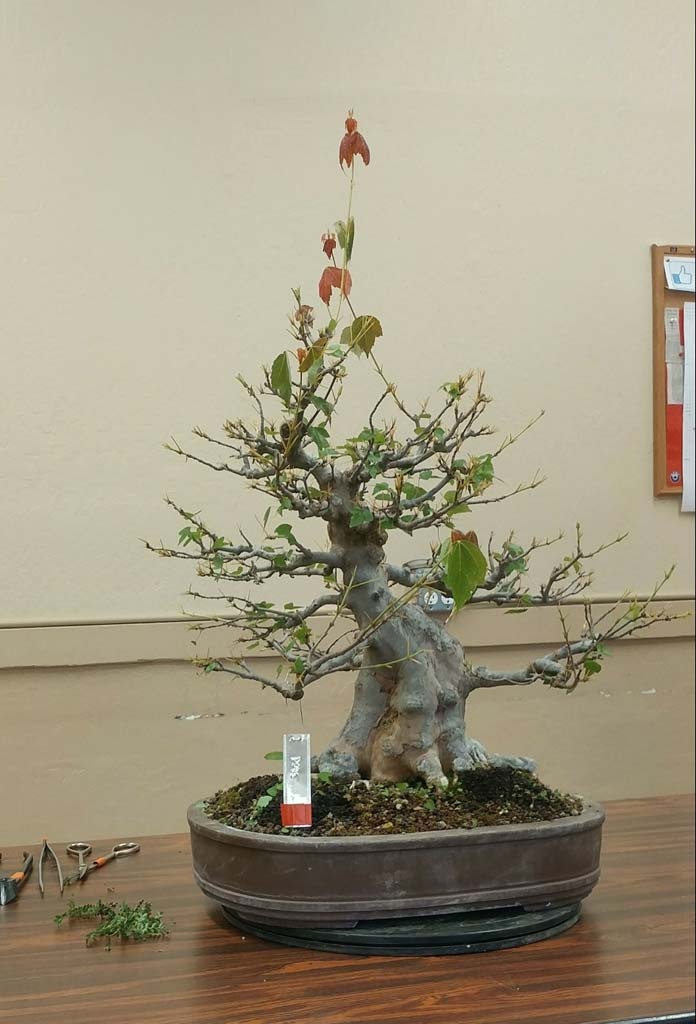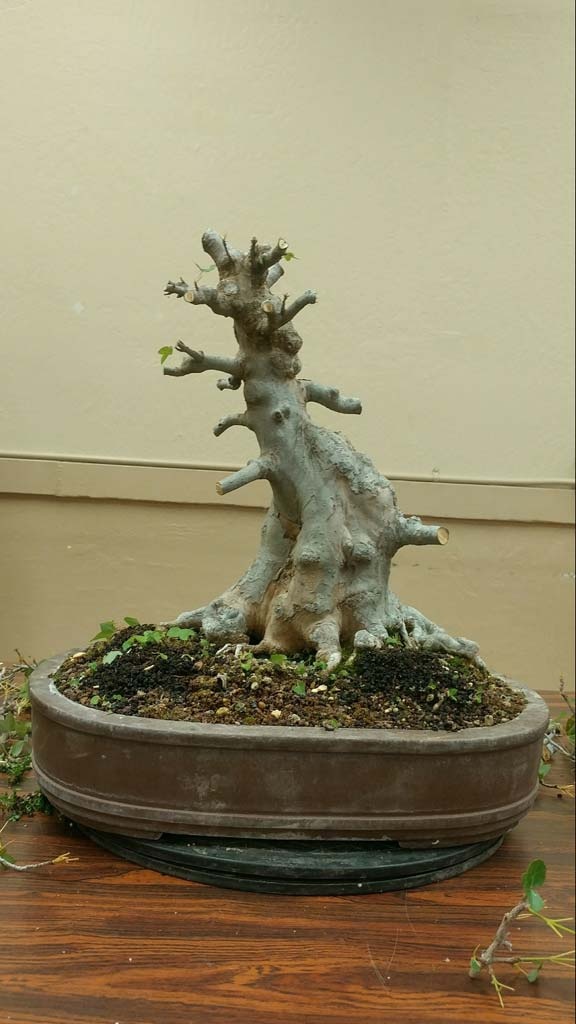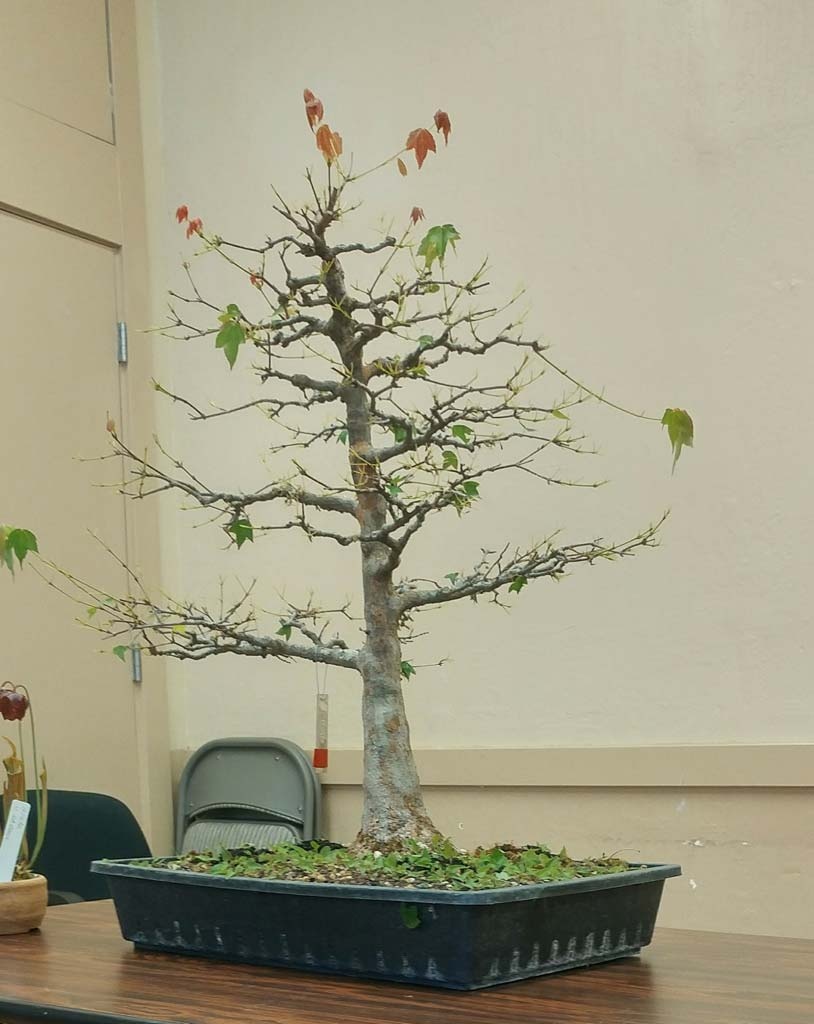Just before his May 7 presentation to the Marin Bonsai Club, Peter Tea wrote on the board nearly the same basic bonsai manipulation tactics he has written up there, and discussed, since his first lecture in our ongoing educational series with him. He listed the three methods of direct manipulation most relevant to the current discussion: Cutting, Pinching, and Defoliation. And then there were the five other main overall ways of inducing change in bonsai: Sun, Water, Soil/Pot, Repot Interval, and Fertilizing.
Not that he was being redundant. Quite the opposite, he was showing the foundation of bonsai methods we have been studying with him for a few years now, and foreshadowing the way in which his talk was about to focus on Cutting and how it really stands alone in contrast to all the other methods he listed. Note that for purposes of his present discussion, Peter minimized his discussion of Pinching and Defoliation, since they’re essentially variations of the same technique: physically altering your tree by removing part of it. His ultimate point was that cutting is a little more dramatic than simply feeding your tree differently or giving it a larger pot, and therefore should be treated as the alternative to those other methods. To emphasize his point, he referred to cutting as “Tactic 2.” The other methods, which Peter collectively referred to as “Tactic 1,” he said may not be as exciting as cutting, but they are ultimately more powerful and controllable in a lot of important ways and should therefore be your first means of altering your bonsai.
But when changes in fertilizer, soil, etc. aren’t accomplishing your goals, it’s time to pick up your tools and do some cutting. And May is certainly the right time of year, because any tree or area of a tree that is getting too much energy will be growing like gangbusters. May is a real busy time for owners of deciduous trees.
Peter makes a point to differentiate between cutting and thinning. Cutting a branch back causes division, which leads to ramification and other desirable aesthetics, but it also slows the tree down, which is often the only real reason for cutting back the branch of a fully developed tree. Thinning, on the other hand, is not just a more widespread approach to removing growth tips from the tree, it’s an important method for revigorating what’s left after you’ve trimmed. What’s left will be stronger, an effect that is particularly helpful if that area was struggling.

Trident Maple before 
Trident Maple after
This cutting/thinning distinction set Peter up for his conclusion later on, when he discussed the way interior growth can suffer despite your isolated attempts to cut back the ends of the branches. If you’re trying to encourage an individual piece of secondary growth to divide and thrive, cutting the end may not be enough, because the tree still does not consider that area to be part of the exterior, or canopy of the tree. In other words, even though there’s nothing growing further out on that particular branch, and you may have cut areas back above, the fact remains that, in relation to the rest of the tree, it’s not at the “outside” of the tree, which is where the tree wants to put its energy. That is why sometimes you just have to cut way back all over the tree and essentially start over. The way Peter puts it, sometimes you just need to “make the inside the outside.”
When he turned to the Seiju elm and two trident maples he brought with him for demonstration purposes, Peter continued to discuss cutting as a secondary tactic and the cutting/thinning distinction, pointing out that internodes can be kept shorter by managing the tree’s energy, not just cutting. The energy can be managed through fertilization, repotting, and the other docile tactics, in addition to the proper use of cutting versus thinning.
As Peter began to cut back hard on one of the trident maples, he included some more tips on both cutting and the other methods for affecting your tree’s energy. For instance, when considering when to feed, it’s important to note that any food a deciduous tree is given in the fall, when it doesn’t actually need it, will be stored until spring and the tree may grow too crazy when it comes out of dormancy. He also took a moment to compare the two tridents, encouraging us to use the observational techniques he has taught us to guess which one is more valuable. Various features of the taller trident, especially its perfect taper, were clues to the most likely fact that its trunk had been fattened through patient care over a lot of time, not the let-grow-and-chop methods we often use to quickly fatten trunks. Although the other trident had a fatter trunk, its juvenile bark and obvious signs of manipulation suggest that it’s probably much younger, and therefore actually less valuable.

Tall Trident before 
Tall Trident after
Two other useful tips that Peter sprinkled throughout his demonstration: Notice that tridents often give a short internode first on a new branch, even if the later ones are longer. This makes trident maples a little easier to cut back than Japanese maples, because you don’t have to remove whole failed branches quite as often. Finally, he tempered the popular notion that growing a “sacrifice” branch can fatten an area of the trunk by pointing out that sacrifice branches only fatten the immediate area near them, often causing bumps or nodules instead of overall fattening. To do that (somewhat abandoned) sacrifice branch technique, you really need multiple sacrifice branches close to one another.
So, for those of us that don’t have perfectly balanced trees, happy trimming!
– David Eichhorn
Photos by Susan Sullivan


